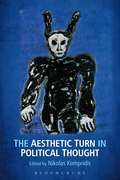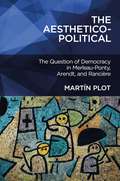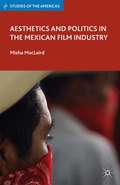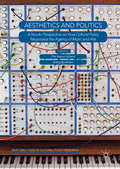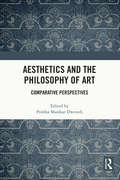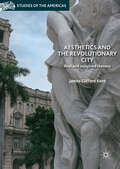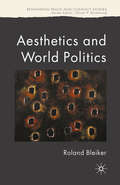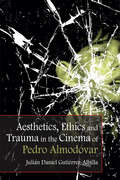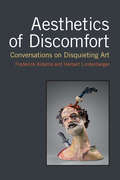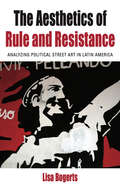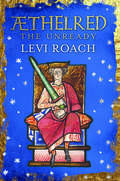- Table View
- List View
The Aesthetic Turn in Political Thought
by Nikolas KompridisThe growing exploration of political life from an aesthetic perspective has become so prominent that we must now speak of an “aesthetic turn” in political thought. But what does it mean and what makes it an aesthetic turn? Why now? This diverse and path-breaking collection of essays answers these questions, provoking new ways to think about the possibilities and debilities of democratic politics.Beginning from the premise that politics is already “aesthetic in principle,” the contributions to The Aesthetic Turn in Political Thought from some of the world's leading political theorists and philosophers, disclose a distinct set of political problems: the aesthetic problems of modern politics. The aesthetic turn in political thought not only recognizes that these problems are different in kind from the standard problems of politics, it also recognizes that they call for a different kind of theorizing – a theorizing that is itself aesthetic.A major contribution to contemporary theoretical debates, The Aesthetic Turn in Political Thought will be essential reading to anyone interested in the interdisciplinary crossroads of aesthetic and politics.
The Aesthetico-Political: The Question of Democracy in Merleau-Ponty, Arendt, and Rancière
by Martín PlotThis study uses new arguments to reinvestigate the relation between aesthetics and politics in the contemporary debates on democratic theory and radical democracy. First, Carl Schmitt and Claude Lefort help delineate the contours of an aesthetico-political understanding of democracy, which is developed further by studying Merleau-Ponty, Rancière, and Arendt. The ideas of Merleau-Ponty serve to establish a general "ontological" framework that aims to contest the dominant currents in contemporary democratic theory. It is argued that Merleau-Ponty, Arendt, and Rancière share a general understanding of the political as the contingently contested spaces and times of appearances. However, the articulation of their thought leads to reconsider and explore under-theorized as well as controversial dimensions of their work.This search for new connections between the political and the aesthetic thought of Arendt and Merleau-Ponty on one hand and the current widespread interest in Rancière's aesthetic politics on the other make this book a unique study that will appeal to anyone who is interested in political theory and contemporary continental philosophy.
The Aesthetico-Political: The Question of Democracy in Merleau-Ponty, Arendt, and Rancière
by Martín PlotThis study uses new arguments to reinvestigate the relation between aesthetics and politics in the contemporary debates on democratic theory and radical democracy. First, Carl Schmitt and Claude Lefort help delineate the contours of an aesthetico-political understanding of democracy, which is developed further by studying Merleau-Ponty, Rancière, and Arendt. The ideas of Merleau-Ponty serve to establish a general "ontological" framework that aims to contest the dominant currents in contemporary democratic theory. It is argued that Merleau-Ponty, Arendt, and Rancière share a general understanding of the political as the contingently contested spaces and times of appearances. However, the articulation of their thought leads to reconsider and explore under-theorized as well as controversial dimensions of their work.This search for new connections between the political and the aesthetic thought of Arendt and Merleau-Ponty on one hand and the current widespread interest in Rancière's aesthetic politics on the other make this book a unique study that will appeal to anyone who is interested in political theory and contemporary continental philosophy.
Aesthetics And Political Culture In Modern Society (Routledge Innovations In Political Theory Series (PDF))
by Henrik Kaare NielsenDo aesthetic appeals to senses and emotions in political debate necessarily marginalise political reason and reduce citizens to consumers – thus dangerously undermining democracy? Or is sensuous-emotional engagement, on the contrary, a basic fact of the political process and a crucial precondition for revitalising democracy? Aesthetics and Political Culture in Modern Society investigates the current interrelationship between aesthetic practice and political practice in Western democracies, focusing on its impact on democratic political culture. Henrik Kaare Nielsen argues that aesthetic interventions in the political process do not by definition undermine politics’ content of reason. Instead, a differentiation must be made between a multiplicity of aesthetic forms of intervention – some of which tend to weaken the political judgement of citizens while other forms tend to stimulate competent judgement. This book will be of interest to scholars in the fields of political science, sociology, media studies, and cultural studies.
Aesthetics and Political Culture in Modern Society (Routledge Innovations in Political Theory)
by Henrik Kaare NielsenDo aesthetic appeals to senses and emotions in political debate necessarily marginalise political reason and reduce citizens to consumers – thus dangerously undermining democracy? Or is sensuous-emotional engagement, on the contrary, a basic fact of the political process and a crucial precondition for revitalising democracy? Aesthetics and Political Culture in Modern Society investigates the current interrelationship between aesthetic practice and political practice in Western democracies, focusing on its impact on democratic political culture. Henrik Kaare Nielsen argues that aesthetic interventions in the political process do not by definition undermine politics’ content of reason. Instead, a differentiation must be made between a multiplicity of aesthetic forms of intervention – some of which tend to weaken the political judgement of citizens while other forms tend to stimulate competent judgement. This book will be of interest to scholars in the fields of political science, sociology, media studies, and cultural studies.
Aesthetics and Political Culture in Modern Society (Routledge Innovations in Political Theory)
by Henrik Kaare NielsenDo aesthetic appeals to senses and emotions in political debate necessarily marginalise political reason and reduce citizens to consumers – thus dangerously undermining democracy? Or is sensuous-emotional engagement, on the contrary, a basic fact of the political process and a crucial precondition for revitalising democracy? Aesthetics and Political Culture in Modern Society investigates the current interrelationship between aesthetic practice and political practice in Western democracies, focusing on its impact on democratic political culture. Henrik Kaare Nielsen argues that aesthetic interventions in the political process do not by definition undermine politics’ content of reason. Instead, a differentiation must be made between a multiplicity of aesthetic forms of intervention – some of which tend to weaken the political judgement of citizens while other forms tend to stimulate competent judgement. This book will be of interest to scholars in the fields of political science, sociology, media studies, and cultural studies.
Aesthetics and Politics in the Mexican Film Industry (Studies of the Americas)
by M. MacLairdEvaluating a broad selection of Mexican films produced from the early 1990s to the present, this study examines how production methods, audience demographics, and aesthetic approaches have changed throughout the past two decades and how these changes relate to the country's transitions to a democratic political system and a free-market economy.
The Aesthetics and Politics of Global Hunger
by Anastasia Ulanowicz Manisha BasuThis collection investigates modern imperialist practices and their management of hunger through its punctuated distribution amongst asymmetrically related marginal populations. Drawing on relevant material from Egypt, Ireland, India, Ukraine, and other regions of the globe, The Aesthetics and Politics of Global Hunger is a rigorously comparative study made up of ten essays by well-established scholars from universities around the world. Since modernity, we have been inhabitants of a globe increasingly connected through discourses of equal access for all humans to the resources of the planet, but the volume emphasizes alongside this reality the flagrant politicization of those same resources. From this emphasis, the essays in the volume place into relief the idea that ideological and aesthetic discourses of hunger could inform ethical thinking and practices about who or what constitutes the figure of the modern historical human.
The Aesthetics and Politics of Global Hunger
by Anastasia Ulanowicz Manisha BasuThis collection investigates modern imperialist practices and their management of hunger through its punctuated distribution amongst asymmetrically related marginal populations. Drawing on relevant material from Egypt, Ireland, India, Ukraine, and other regions of the globe, The Aesthetics and Politics of Global Hunger is a rigorously comparative study made up of ten essays by well-established scholars from universities around the world. Since modernity, we have been inhabitants of a globe increasingly connected through discourses of equal access for all humans to the resources of the planet, but the volume emphasizes alongside this reality the flagrant politicization of those same resources. From this emphasis, the essays in the volume place into relief the idea that ideological and aesthetic discourses of hunger could inform ethical thinking and practices about who or what constitutes the figure of the modern historical human.
Aesthetics and Politics (PDF)
by Ole Marius Hylland Erling BjurströmThrough comparative and integrated case studies, this book demonstrates how aesthetics becomes politics in cultural policy. Contributors from Norway, Sweden and the UK analyse exactly what happens when art is considered relevant for societal development, at both a practical and theoretical level. Cultural policy is seen here as a mechanism for translating values, that through organized and practical aesthetical judgement lend different forms of agency to the arts. What happens when aesthetical value is reinterpreted as political value? What kinds of negotiations take place at a cultural policy ground level when values are translated and reinterpreted? By addressing these questions, the editors present an original collection that effectively centralises and investigates the role of aesthetics in cultural policy research.
Aesthetics and the Philosophy of Art: Comparative Perspectives
by Prabha Shankar DwivediThis volume brings together the finest research on aesthetics and the philosophy of art by stalwart critics and leading scholars in the field. It discusses various themes, such as the idea of aesthetic perception, the nature of aesthetic experience, attitude theory, the relation of art to morality, representation in art, and the association of aesthetics with language studies in the Indian tradition. It deliberates over the theories and views of Aristotle, Freud, Plato, Immanuel Kant, T. S. Eliot, George Dickie, Leo Tolstoy, R. G. Collingwood, Michael H. Mitias, Monroe C. Beardsley, and Abhinavagupta, among others. The book offers a comparative perspective on Indian and Western approaches to the study of art and aesthetics and enables readers to appreciate the similarities and differences between the conceptions of aesthetics and philosophy of art on a comparative scale detailing various aspects of both. The first of its kind, this key text will be useful for scholars and researchers of arts and aesthetics, philosophy of art, cultural studies, comparative literature, and philosophy in general. It will also appeal to general readers interested in the philosophy of art.
Aesthetics and the Philosophy of Art: Comparative Perspectives
by Prabha Shankar DwivediThis volume brings together the finest research on aesthetics and the philosophy of art by stalwart critics and leading scholars in the field. It discusses various themes, such as the idea of aesthetic perception, the nature of aesthetic experience, attitude theory, the relation of art to morality, representation in art, and the association of aesthetics with language studies in the Indian tradition. It deliberates over the theories and views of Aristotle, Freud, Plato, Immanuel Kant, T. S. Eliot, George Dickie, Leo Tolstoy, R. G. Collingwood, Michael H. Mitias, Monroe C. Beardsley, and Abhinavagupta, among others. The book offers a comparative perspective on Indian and Western approaches to the study of art and aesthetics and enables readers to appreciate the similarities and differences between the conceptions of aesthetics and philosophy of art on a comparative scale detailing various aspects of both. The first of its kind, this key text will be useful for scholars and researchers of arts and aesthetics, philosophy of art, cultural studies, comparative literature, and philosophy in general. It will also appeal to general readers interested in the philosophy of art.
Aesthetics and the Revolutionary City: Real and Imagined Havana (Studies of the Americas)
by James Clifford KentAesthetics and the Revolutionary City engages in alternative ways of reading foreign visual representations of Havana through analysis of advertising images, documentary films, and photographic texts. It explores key narratives relating to the projection of different Havana imaginaries and focuses on a range of themes including: pre-revolutionary Cuba; the dream of revolution; and the metaphor of the city “frozen-in-time.” The book also synthesizes contemporary debates regarding the notion of Havana as a real and imagined city space and fleshes out its theoretical insights with a series of stand-alone, important case studies linked to the representation of the Cuban capital in the Western imaginary. The interpretations in the book bring into focus a range of critical historical moments in Cuban history (including the Cuban Revolution and the “Special Period”) and consider the ways in which they have been projected in advertising, documentary film and photography outside the island.
Aesthetics and World Politics (Rethinking Peace and Conflict Studies)
by R. BleikerThis book presents one of the first systematic assessments of aesthetic insights into world politics. It examines the nature of aesthetic approaches and outlines how they differ from traditional analysis of politics. The book explores the potential and limits of aesthetics through a series of case studies on language and poetics.
Aesthetics, Ethics and Trauma in the Cinema of Pedro Almodóvar
by Julián Daniel Gutiérrez-AlbillaA comparative analysis of key Islamic ity platforms and their debates
Aesthetics, Ethics and Trauma in the Cinema of Pedro Almodóvar
by Julián Daniel Gutiérrez-AlbillaDiscover Ernesto Laclau's theory of antagonism and how it contributes to political and cultural thought
Aesthetics of Discomfort: Conversations on Disquieting Art
by Frederick L Aldama Herbert S LindenbergerThrough a series of provocative conversations, Frederick Luis Aldama and Herbert Lindenberger, who have written widely on literature, film, music, and art, locate a place for the discomforting and the often painfully unpleasant within aesthetics. The conversational format allows them to travel informally across many centuries and many art forms. They have much to tell one another about the arts since the advent of modernism soon after 1900—the nontonal music, for example, of the Second Vienna School, the chance-directed music and dance of John Cage and Merce Cunningham, the in-your-faceness of such diverse visual artists as Francis Bacon, Pablo Picasso, Willem de Kooning, Egon Schiele, Otto Dix, and Damien Hirst. They demonstrate as well a long tradition of discomforting art stretching back many centuries, for example, in the Last Judgments of innumerable Renaissance painters, in Goya’s so-called “black” paintings, in Wagner’s Tristan chord, and in the subtexts of Shakespearean works such as King Lear and Othello. This book is addressed at once to scholars of literature, art history, musicology, and cinema. Although its conversational format eschews the standard conventions of scholarly argument, it provides original insights both into particular art forms and into individual works within these forms. Among other matters, it demonstrates how recent work in neuroscience may provide insights in the ways that consumers process difficult and discomforting works of art. The book also contributes to current aesthetic theory by charting the dialogue that goes on—especially in aesthetically challenging works—between creator, artifact, and consumer.
Aesthetics of Equality
by Michael J. ShapiroPresuming that the problem of political equality, as it bears on both persons and assemblages, is about being accorded access to the material and symbolic resources needed to manage an effective civic presence, Michael J. Shapiro's critical interventions engage the way aesthetic genres illustrate this problem. Addressing literary, cinematic, photographic, musical, art historical, and architectural compositions, Shapiro's inquiries encounter the way a wide variety of texts elevate voices, bodies, and life dramas that have existed below thresholds of recognition. In Aesthetics of Equality, Shapiro offers a guide to aesthetic methods that emphasize the way writing strategies engage diverse artistic genres to articulate political problems. Emphasizing relationships between compositional form and ideational commitment, while focusing on the texts' protagonists (aesthetic subjects), the analyses cover a wide variety of spaces and historical moments in scenes ranging from ancient Israel and Egypt in the Old Testament's Genesis to the ethno-histories of California and Texas, with attention on the right to urban space in such megacities as Paris, New York, Los Angeles, and Istanbul.
Aesthetics of Equality
by Michael J. ShapiroPresuming that the problem of political equality, as it bears on both persons and assemblages, is about being accorded access to the material and symbolic resources needed to manage an effective civic presence, Michael J. Shapiro's critical interventions engage the way aesthetic genres illustrate this problem. Addressing literary, cinematic, photographic, musical, art historical, and architectural compositions, Shapiro's inquiries encounter the way a wide variety of texts elevate voices, bodies, and life dramas that have existed below thresholds of recognition. In Aesthetics of Equality, Shapiro offers a guide to aesthetic methods that emphasize the way writing strategies engage diverse artistic genres to articulate political problems. Emphasizing relationships between compositional form and ideational commitment, while focusing on the texts' protagonists (aesthetic subjects), the analyses cover a wide variety of spaces and historical moments in scenes ranging from ancient Israel and Egypt in the Old Testament's Genesis to the ethno-histories of California and Texas, with attention on the right to urban space in such megacities as Paris, New York, Los Angeles, and Istanbul.
The Aesthetics of Free Speech: Rethinking the Public Sphere
by J. RobertsThe Aesthetics of Free Speech: Rethinking the Public Sphere is one of the first books to theoretically explore the relationship between free speech and the public sphere. By drawing upon Marxist theory the author, John Michael Roberts, demonstrates how liberal theorists frequently construct an abstract aesthetic of 'rational', 'cultivated' and 'competent' discussion which then serves as a norm through which certain utterances can be humiliated and excluded from participating fully within the public sphere. However, the author also shows how excluded utterances develop their own aesthetic of free speech and how this aesthetic then comes back to haunt the bourgeois public sphere.
The Aesthetics of Gyorgy Lukacs
by Bela KiralyfalviThis book-length treatment of György Lukács' major achievement, his Marxist aesthetic theories. Working from the thirty-one volumes of Lukács' works and twelve separately published essays, speeches, and interviews, Bela Kiralyfalvi provides a full and systematic analysis for English-speaking readers. Following an introductory chapter on Lukács' philosophical development, the book concentrates on the coherent Marxist aesthetics that became the basis for his mature literary criticism. The study includes an examination of Lukács' Marxist philosophical premises; his theory of the origin of art and the relationship of art to life, science, and religion; and his theory of artistic reflection and realism. Later chapters treat the concepts of type and totality in Lukács' category of specialty, the distinctions between allegory and symbolism in his theory of the language of art, and Lukács' understanding of aesthetic effect and form and content in art. There is a separate chapter on Lukács' dramatic theory. This lucid and readable account of Lukács' aesthetic theories will be of special interest to students of literature, aesthetics, and drama. In addition, it will be appreciated by those generally concerned with Marxist theory.Originally published in 1975.The Princeton Legacy Library uses the latest print-on-demand technology to again make available previously out-of-print books from the distinguished backlist of Princeton University Press. These editions preserve the original texts of these important books while presenting them in durable paperback and hardcover editions. The goal of the Princeton Legacy Library is to vastly increase access to the rich scholarly heritage found in the thousands of books published by Princeton University Press since its founding in 1905.
The Aesthetics of Rule and Resistance: Analyzing Political Street Art in Latin America (Protest, Culture & Society #29)
by Lisa BogertsEffective visual communication has become an essential strategy for grassroots political activists, who use images to publicly express resistance and make their claims visible in the struggle for political power. However, this “aesthetics of resistance” is also employed by political and economic elites for their own purposes, making it increasingly difficult to distinguish from the “aesthetics of rule.” Through illuminating case studies of street art in Buenos Aires, Bogotá, Caracas, and Mexico City, The Aesthetics of Rule and Resistance explores the visual strategies of persuasion and meaning-making employed by both rulers and resisters to foster self-legitimization, identification, and mobilization.
The Aesthetics of Rule and Resistance: Analyzing Political Street Art in Latin America (Protest, Culture & Society #29)
by Lisa BogertsEffective visual communication has become an essential strategy for grassroots political activists, who use images to publicly express resistance and make their claims visible in the struggle for political power. However, this “aesthetics of resistance” is also employed by political and economic elites for their own purposes, making it increasingly difficult to distinguish from the “aesthetics of rule.” Through illuminating case studies of street art in Buenos Aires, Bogotá, Caracas, and Mexico City, The Aesthetics of Rule and Resistance explores the visual strategies of persuasion and meaning-making employed by both rulers and resisters to foster self-legitimization, identification, and mobilization.
The Aesthetics of Rule and Resistance: Analyzing Political Street Art in Latin America (Protest, Culture & Society #29)
by Lisa BogertsEffective visual communication has become an essential strategy for grassroots political activists, who use images to publicly express resistance and make their claims visible in the struggle for political power. However, this “aesthetics of resistance” is also employed by political and economic elites for their own purposes, making it increasingly difficult to distinguish from the “aesthetics of rule.” Through illuminating case studies of street art in Buenos Aires, Bogotá, Caracas, and Mexico City, The Aesthetics of Rule and Resistance explores the visual strategies of persuasion and meaning-making employed by both rulers and resisters to foster self-legitimization, identification, and mobilization.
Æthelred: The Unready
by Dr. Levi RoachAn imaginative reassessment of Æthelred "the Unready," one of medieval England’s most maligned kings and a major Anglo-Saxon figure The Anglo-Saxon king Æthelred "the Unready" (978–1016) has
